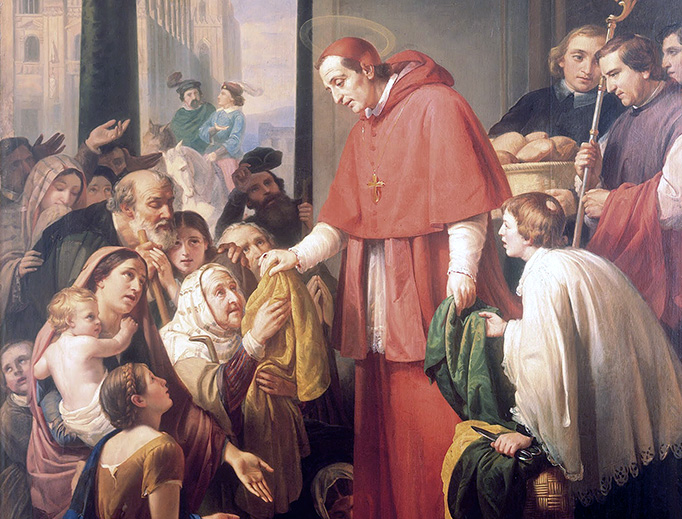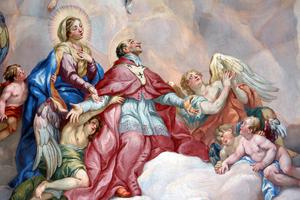How St. Charles Borromeo Can Help Form Priests Today
Don’t just pray for more priests. Pray for more happy, holy and healthy priests.

Monsignor John Cihak, a priest of the Archdiocese of Portland in Oregon, along with Benedictine Brother Ansgar Santogrossi, acting as translator, has offered us a tremendous gift as a Catholic people: a collection of homilies, speeches, and writings of one of the most important figures in the history of the Catholic Church, Saint Charles Borromeo. Msgr. Cihak’s text, Charles Borromeo: Selected Orations, Homilies and Writings (Bloomsbury, 2017) is a treasure and I highly recommend it for all people.
The book, which collects some of the most important writings of the saint, has helped me reflect on many things: the life and legacy of this great saint, the state of the Church in the time after the Protestant Reformation, and my own role as a priest formator and professor in a seminary. I must admit that I was in the seminary with Msgr. Cihak and studied and worked in Rome while Msgr. Cihak was working for the Vatican and I can attest that he is a very fine priest and theologian.
Saint Charles Borromeo (1538-1584) recognized what was happening to the priests of his day. Some were lax, lazy and lethargic, unable to articulate the great mysteries that had been handed on to them. Some were basically functionaries, celebrating Mass after Mass, and taking stipend after stipend, by and large concerned with the things of this world, rather than the things of the world to come. Many were secular priests — diocesan priests (like myself) living in the saecula, the world — but some were becoming truly secular in the worst sense of the word. And even some of the regular (religious order) priests, including the mendicant friars, weren’t much better.
The priesthood was in a sad state. A family would go and apprentice a boy to a parish priest for a few years and, having paid the priest a hefty dowry, leave him there to learn. Often, these priests would let their young charges go throughout Europe, sowing their wild oats, and, without any level of formation, return to the priest, who would then go and recommend to the local bishop that he should ordain the young man.
Saint Charles Borromeo saw the need for a dedicated space, a seed-bed, a seminary, where young men could come together for true formation, not simply a functional formation, not only teaching them what to do, but more importantly teaching them who they were, always recognizing that their ontology, who they were to become, was certainly more important than what they were to do.
The seminary is basically a place that is the template model for how the priest should live. Saint Charles Borromeo’s basic model of seminary is what we have today around the world. I am blessed to have attended the seminaries that I did, all enriching me at the level of formation I needed: Cathedral Preparatory Seminary and Cathedral Seminary Residence in New York and the Pontifical North American College in Rome, Italy. I have been doubly blessed to have served as a faculty member of some of the seminaries that formed me.
We think that the formation of priests is hard today. It has always been hard and will never be easy. It’s not simply enough to teach the seminarian what he needs to know academically or pastorally in terms of the practical. It requires a holistic development of the whole man, in terms of his growth in the areas of his human formation, his spiritual formation, his intellectual formation, and his pastoral formation. This is why seminary takes so long for a man to complete. Formation is the process of disintegrating the individual and the process of integrating the individual back into the world according to the model of Jesus Christ. It is the process of breaking the pot and reshaping it, according to the template of the Church.
And these pots that present themselves to us for ordination today were hardened so much earlier than many of us priests who are older were; in an age of confused masculinity, with no father figures for many of them, with notions of sexuality warped by pornography, of privilege, of never being told no, of either helicoptering or absence parents, we who serve as seminary formators have our work cut out for us. And seminary formators have to realize that we have to deal with all that’s going on in our own lives, dissipating the cognitive distortions that can so affect our lives — trying, despite our own weaknesses, to offer, in our own lives and examples, a priestly role model, a priest whom the seminarian can truly call “Father.”
Two things to remember: First, the old adage: the seminarian you are, the priest you will be. Please pray for seminarians. As one who is engaged as a formator in a major seminary, I can truly attest that we have heroic men in the seminary, men striving for sanctity of life and trying to be holistic men for Christ and his Church.
And please don’t just pray for more vocations. We really don’t need just more numbers, although it is nice to have; What we need are happy, holy, healthy priests. The Program for Priestly Formation #71 reads:
The goal is the development not just of a well-rounded person, a prayerful person, or an experienced pastoral practitioner but rather one who understands his spiritual development within the context of his call to service in the Church, his human development within the greater context of his call to advance the mission of the Church, his intellectual development as the appropriation of the Church’s teaching and tradition, and his pastoral formation as participation in the active ministry of the Church.
Not an easy task, but seminary formators today are blessed with many guides given to us from the Church: Saint John Paul II’s Pastore Dabo Vobis (1992), the aforementioned Program of Priestly Formation, and Pope Francis’ The Gift of the Priestly Vocation (2016).
Second, as the rector and seminary formators act, so the seminarians will do, often in reaction. Please pray for me and other seminary formators. We have to be the best priests we can be because we need to help the Lord form priests for the future, and, in doing so, help to assure that our Mother, the Church, can offer her children shepherds after the Sacred Heart of Christ. Father Jean-Jacques Olier (the founder of the Society of St. Sulpice, a group of priests dedicated to the formation of future priests) had one main desire for his seminary formators: that they would want “to live supremely for God in Christ Jesus our Lord, so much so that the inner life of His only Son should penetrate to the inmost depths of our heart and to such an extent that everyone should be able to say, ‘It is no longer I who live, but Christ who lives in me.’”
It is a heavy burden, but it is also a true joy, and I for one, am grateful to Saint Charles for his foundation of the modern seminary system and to have a part in this ministry at this time in my life.
Please join me in praying this prayer of Saint Charles Borromeo for zealous priests:
O Holy Mother of God, pray for the priests your Son has chosen to serve the Church. Help them, by your intercession, to be holy, zealous and chaste. Make them models of virtue in the service of God's people. Help them be pious in meditation, efficacious in preaching, and zealous in the daily offering of the Holy Sacrifice of the Mass. Help them administer the Sacraments with love and joy. Amen.
- Keywords:
- st. Charles borromeo
- priests
- priesthood
















